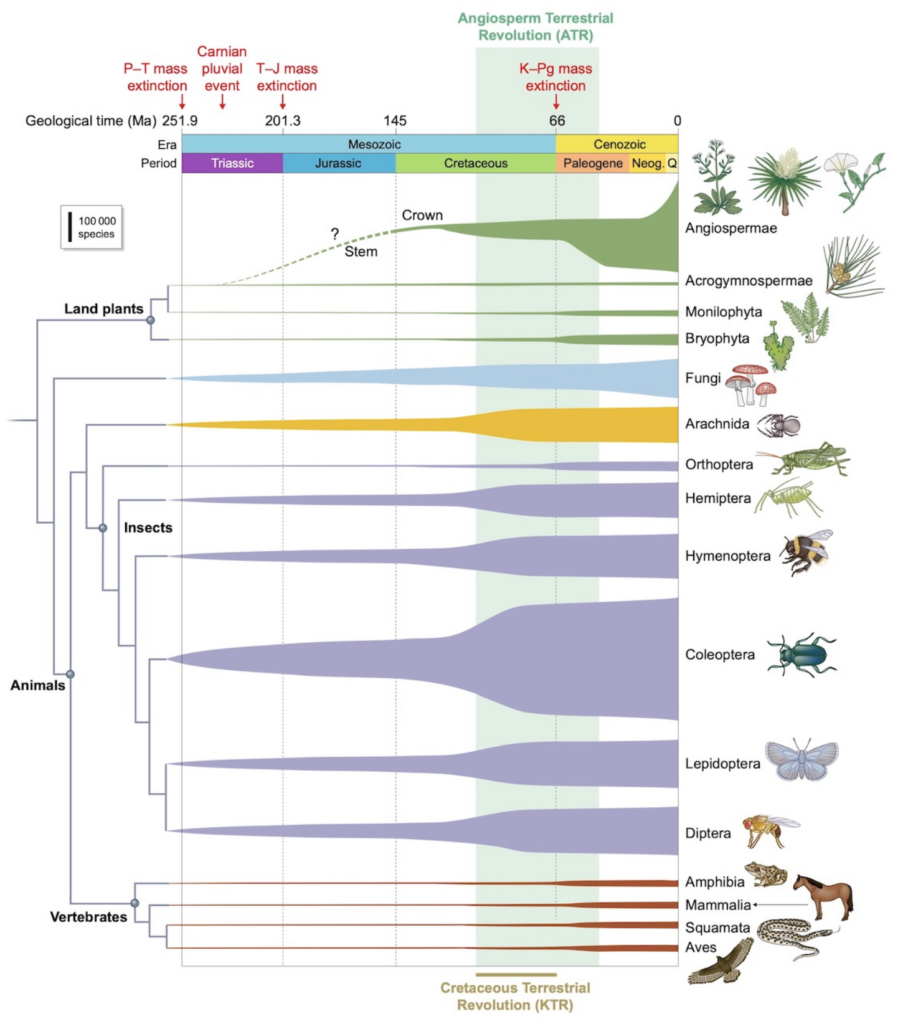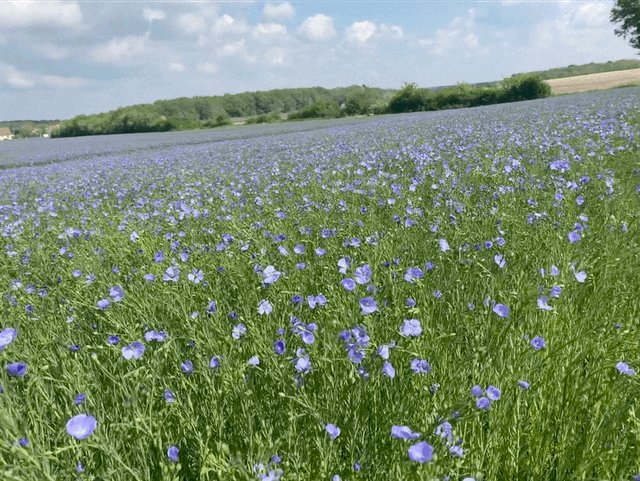Lesson : Reproduction of the flowering plants
Flowering plants owe their evolutionary success to their reproductive system: the flower. The difficulty, once fixed, is both the meeting of gametes and the dispersal of seeds. The strategies used by flowering plants are extremely varied: from small, colourless, odourless flowers to giant, highly coloured, very fragrant flowers… every means is used to cleverly transport pollen to the ovules… but the variability of strategies for transporting seeds is just as great. To gain a better understanding of these diverse strategies, we need to look first at the structure of a flower, an essential organ that has enabled Angiosperms to colonise all environments.
I- The structure of the flower
A- The flower
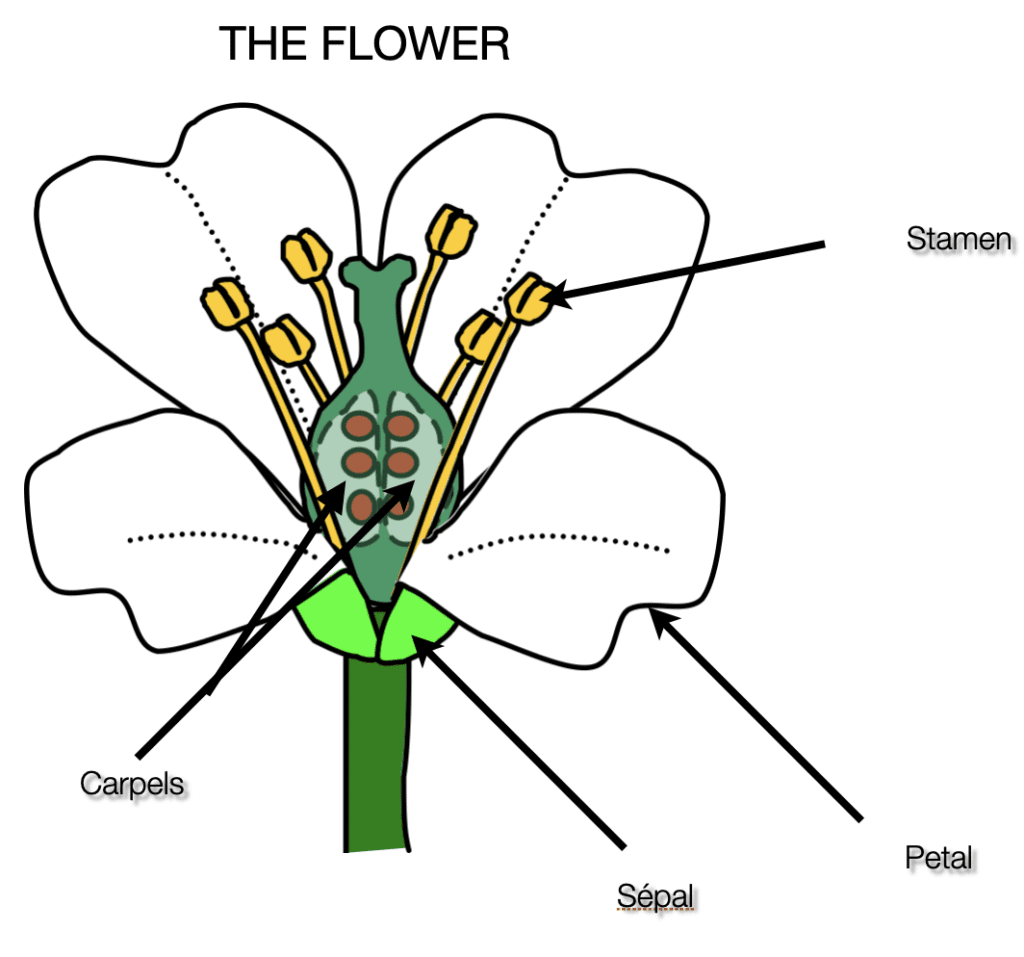
Flower parts:
Sepals – protect flower when it is a bud (usually green).
Petals – large, brightly coloured and scented to attract insects in animal-pollinated plants. Small, green or absent in wind-pollinated plants.
Stamen (male) composed of anther and filament. Anther produces pollen grains and filament supports anther and supplies it with food and water.
Carpel (female)- composed of stigma, style and ovary.
Stigma is where pollen land.
Style is where the pollen tube grows towards the ovary.
Receptacle – swelling on which flower is supported.
Nectary – This structure produces sugary substance called nectar. Attracts insects for pollination.
The flower diagram and formula:

B- The stamen’s structure :
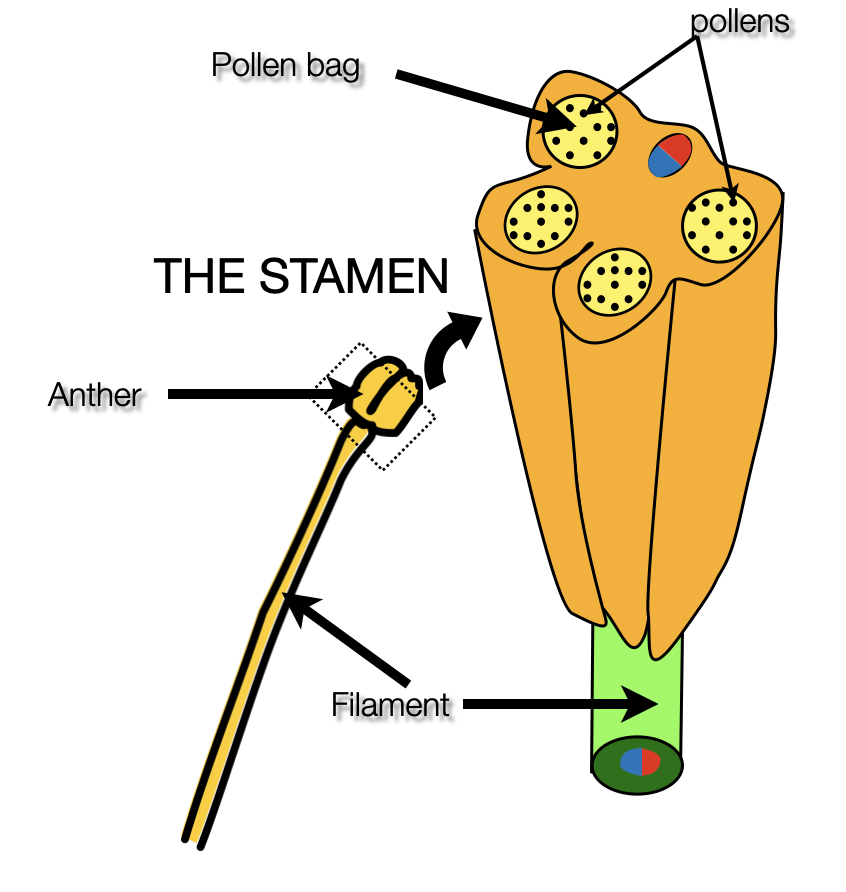
The stamens are composed of a filament and anthers. Each anther has four pollen sacs producing the male gametes or pollen. The filament holds the anther up.
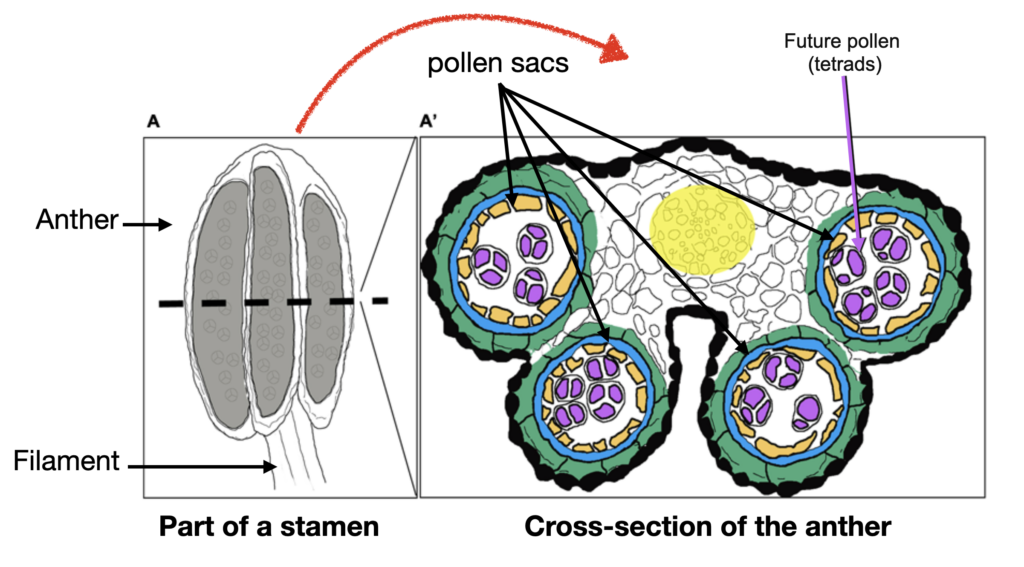
C- The carpel’s structure
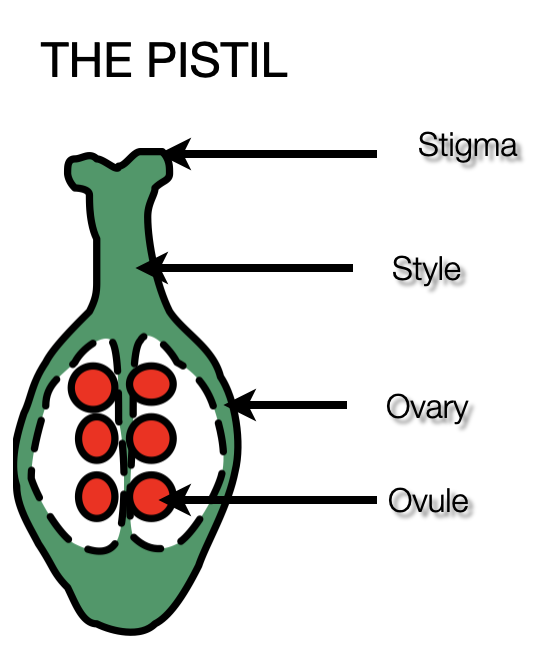
The carpel is the female reproductive organ of a flowering plant. Consisting of three parts including the stigma, style, and ovary, the carpel works with the stamen to facilitate pollination.
II- Production of gametes
Gametes are haploid sex cells.
Sexual reproduction involves the fusion of gametes from both parents.
- Pollination: the transfer of pollen from anther to stigma.
- Fertilisation: fusion of male and female gametes to form a zygote.
- Dispersal: the spreading out of the seeds.
- Germination: the growth of the plant embryo after the dormant period.
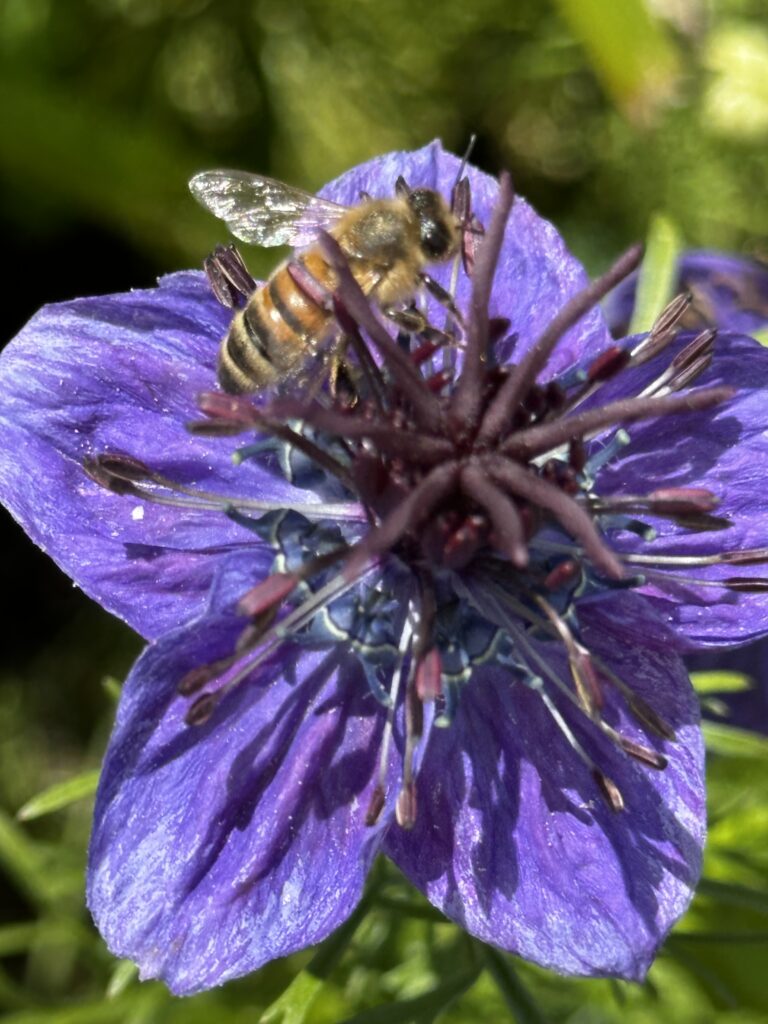
Development of pollen
Pollen grain produces male gametes by meiosis.
1. Inside each pollen sac are a number of diploid pollen mother cells which divide by meiosis to form four haploid pollen grains which stick together (tetrad).
2. The pollen grains (microspores – called spores because unable to fertilise a female gamete) separate. Each pollen grain has a double wall (*exine on the outside, intine).
3. The pollen grain nucleus divides by mitosis to form two haploid nuclei (tube nucleus and generative nucleus).
4. As the pollen grains mature, the tapetum (nourishment) is used up, the pollen sacs fuse and lines of dehiscence (splitting) appear, the sacs burst and the pollen grains are removed by insects or wind.

Development of embryo sac
Embryo sac produces an egg cell and polar nuclei.
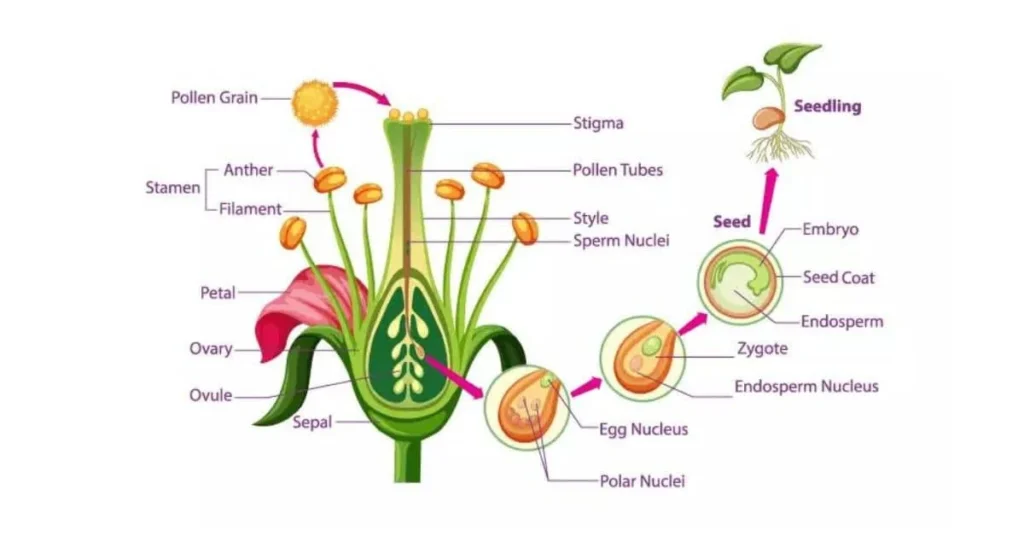
The diploid embryo sac mother cell divides by meiosis to form four haploid cells, three of which die. The single haploid nucleus within the embryo sac (megaspore) undergoes mitosis 3 times (i.e. 8 haploid nuclei). One forms the egg cell and two form the polar nuclei (all three = female gametes).
*Pollination is the transfer of pollen from an anther to a stigma of a flower of the same species.
*Cross -pollination is the transfer of pollen from the anther of one plant to the stigma of another plant of the same species.
*Self-pollination occurs when pollen is transferred from the anther to the stigma of the same flower or to another flower on the same plant e.g. cereals.
Cross pollination ensures seeds show more variation and vigour.
It may be brought about by wind or animals.
| Animal pollinated | Wind pollinated | |
| Flower | Large, brightly coloured petals, scented and nectar to attract and reward insects. | Small and petals green if present, no scent/nectar. |
| Pollen | Small amount of large, heavy, sticky, spiky pollen – to attach to insect’s body. | Large amounts, small, light, dry, round, smooth pollen – easily carried by wind, large nos. allows for wastage. |
| Stigmas | Small, round, sticky, inside flower – forces insect to forage. | Large, feathery, outside flower easier to catch pollen. |
| Anthers | Small, inside flower – forces insect to forage e.g. wall flower, sweet pea, tulip, snowdrops. | Large, outside flower – for easy release of pollen e.g. grass, oak, hazel, alder, conifers. |
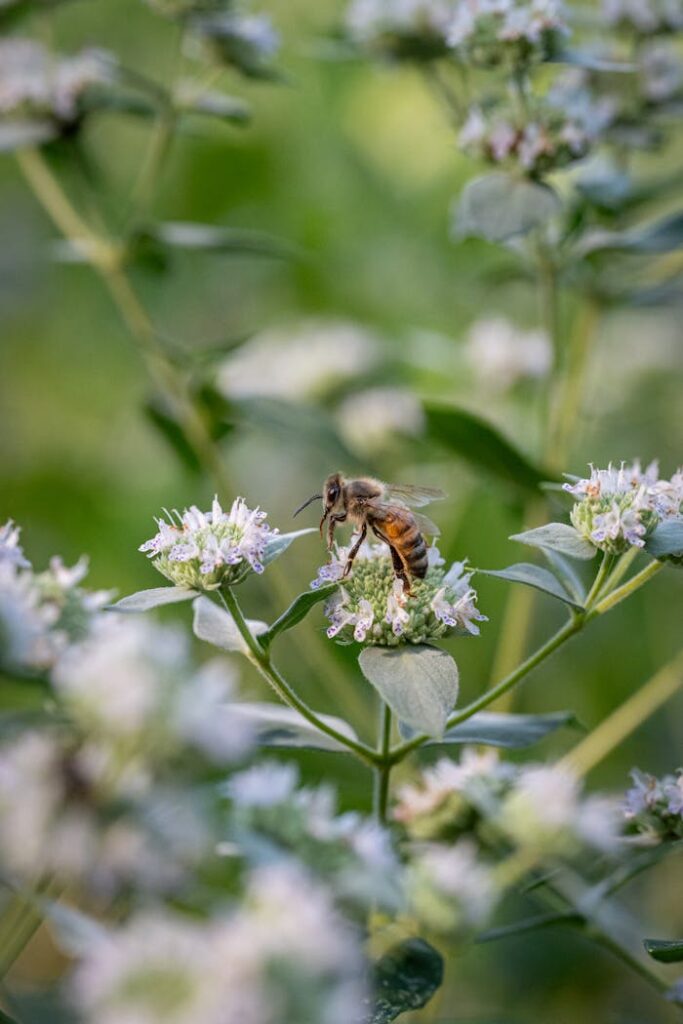
Plants such as wheat, which grows quickly, are resistant to disease and pests, and produce a large amount of good quality pollen. Cross-pollination can be brought about artificially. The anthers are removed from one plant – to prevent self-pollination. When the carpels are ripe, pollen from the second plant is dusted on using a brush and plant is covered.
Can also be achieved by tissue culturing. A piece of tissue is taken from plant, grown in nutrient medium until a mass of cells forms. One cell is taken and grown in another medium and a new plant is formed.
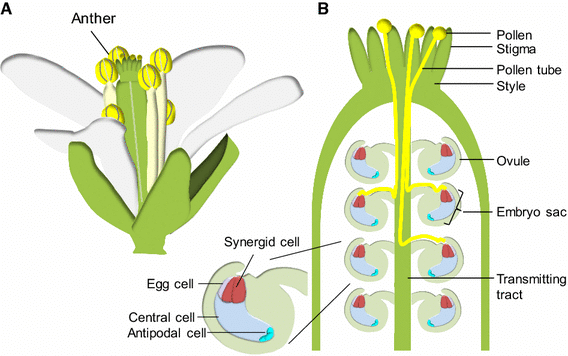
Fertilisation – union of male & female gametes to form a diploid zygote
Once the pollen grain lands on the stigma it produces a pollen tube, which grows down the style to the ovule.
As the pollen tube grows down, the generative nucleus (n) divides by mitosis to form two sperm nuclei (male gametes) (n). The tube is guided by chemotropism and by the tube nucleus which dies when the tube enters the ovule by the micropyle.
Double fertilisation occurs:
One sperm nucleus fuses with the egg nucleus to produce a diploid zygote (2n).
The second sperm nucleus fuses with the two polar nuclei to form a triploid endosperm nucleus (3n)
The zygote develops into an embryo plant and the endosperm forms a food supply for embryo.
Seed/fruit formation
ovule becomes the seed.
integuments become the testa (seed coat)
ovary becomes the fruit (or a modified floral part e.g. apple & strawberry (from receptacle)
ovary wall becomes the pericarp (fruit wall)
Developing seeds produce growth regulators to stimulate growth of the fruit tissues.
Seed structure
Testa: tough hard seed coat. Protects seed before germination.
Hilum: Scar. Left by stalk which attached ovule to ovary wall.
Micropyle: pore
Embryo consist of the radicle, plumule and cotyledons:
Radicle: develops into the root.
Plumule: develops into the shoot.
Cotyledons: seed leaves – formed by some of the embryo cells. These contain food reserves which are used in the early stage of germination – before the young plant can make its own food. They secrete enzymes which digest endosperm food, absorb it and pass it on to the developing embryo.
Classification of seeds:
- Number of cotyledons
Monocot – 1 cotyledon (1 seed leaf) e.g. grass, cereals, daffodils
Dicot – 2 cotyledons (2 seed leaves) e.g. broad bean, pea, sunflower, peanuts.
- Endosperm: endospermic seeds have an endosperm e.g. maize; non– endospermic seeds have no endosperm e.g. broad bean.
A monocot : the maize
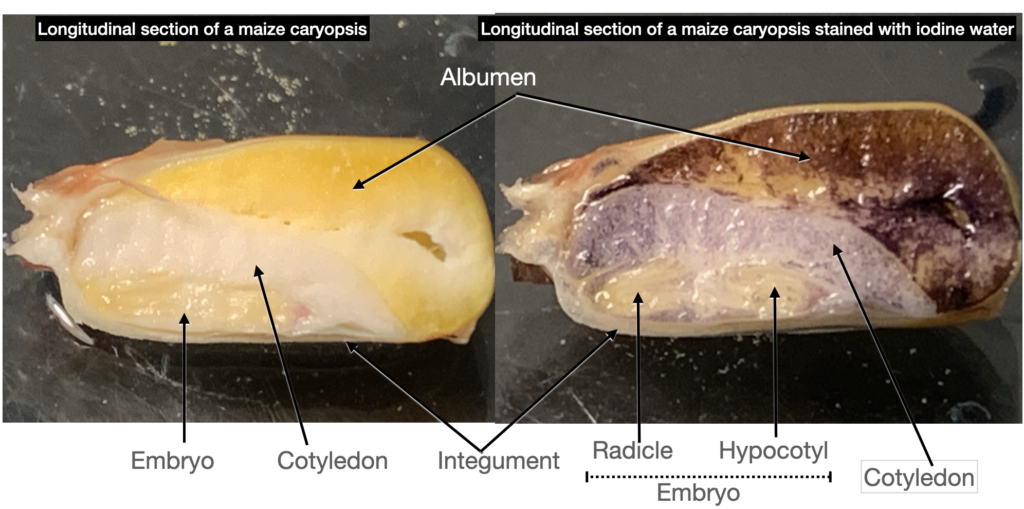
A dicot : the bean
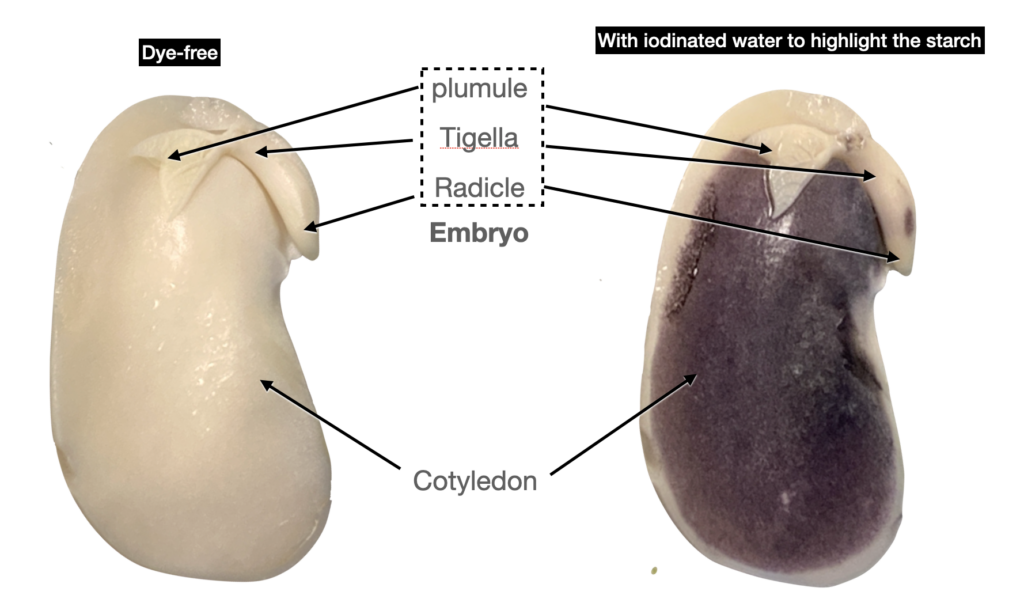
Dormancy – resting periods where seeds undergo no growth & have reduced cell activity/ metabolism
Causes: Growth inhibitors
Testa impermeable to water/oxygen
Testa too tough – embryo can’t emerge
Lack of growth regulator
Advantages: Plants avoid harsh conditions
Time for embryo to develop fully
Maximises growing season
Germination – regrowth of embryo after period of dormancy if environmental conditions are suitable.
Conditions required W.O.W
Water Oxygen Warmth (temp.)
Main events in germination
- Seed absorbs water
- Stored foods digested by enzymes in seed
- Digested foods transferred to embryo from cotyledons/endosperm
- -some digested foods make new structures
- -some used in respiration
- Radicle grows down & bursts through testa
- Plumule emerges above ground
- New leaves form
To go further: How Do Hummingbirds Help Pollination?
go to Pollinator.org
The evolution of modern plants and animals, showing how the rise of angiosperms through the past 200 million years was accompanied by massive expansion in biodiversity of numerous key groups of insects (such as bees, wasps, butterflies, bugs, beetles, and flies).
